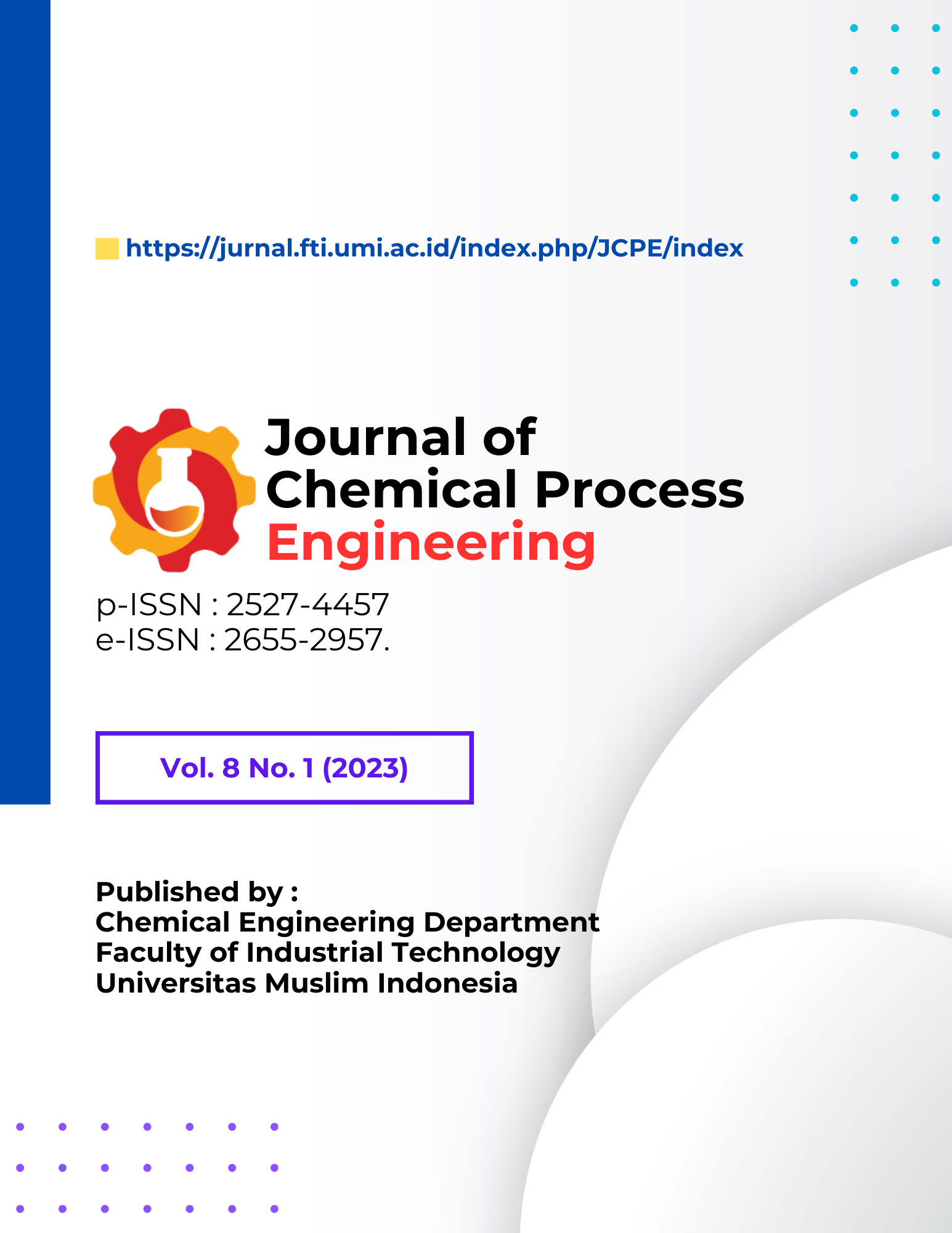Pengaruh Aliran Nitrogen Kontinyu ke Dalam Reaktor Pirolisis Limbah Biomassa Serbuk Gergaji Batang Kelapa (Cocos Nucifera) Terhadap Nilai Kalor.
DOI:
https://doi.org/10.33536/jcpe.v8i1.754Keywords:
Biomassa, Batang kelapa, Gas Inert Nitrogen, Arang, PirolisisAbstract
Potensi jumlah biomassa serbuk gergaji batang kelapa di Indonesia sangat besar, selama ini belum dimanfaatkan secara maksimal dan cendrung terbuang sebagai limbah. Serbuk gergaji batang kelapa dengan komposisi utama karbon mengandung kalor setara batubara muda yaitu sekitar 4400 kkal/kg. Walaupun nilai kalornya masih rendah namun potensi dijadikan sumber bahan bakar padat atau sumber energi alternatif. Nilai kalor serbuk gergaji batang kelapa tersebut dapat ditingkatkan melalui proses pirolisis. Dilakukan penelitian pengaruh gas inert nitrogen yang dialirkan secara kontinyu ke dalam reaktor pirolisis limbah biomassa serbuk gergaji batang kelapa (cocos nucifera) terhadap nilai kalor charcoal yang dihasilkan. Tujuan penelitian ingin menentukan efek dan lajur alir optimum gas inert nitrogen yang memberikan nilai kalor produk charcoal yang maksimum. Dari penelitian ini disimpukan bahwa pengaliran secara kontinyu gas inert nitrogen ke dalam reaktor pirolisis berpengaruh terhadap peningkatan nilai kalor produk charcoal mencapai 4% dibanding tanpa menggunakan gas inert tersebut. Laju alir gas nitrogen optimum adalah 2 L/menit memberikan nilai kalor yang sudah efektif maksimum sebesar 7200 kkal/kg.
Downloads
References
“Produksi Tanaman Perkebunan,” 2021. [Online]. Available: https://www.bps.go.id/indicator/54/132/1/produksi-tanaman-perkebunan.html.
P. Kumar, D. M. Barrett, M. J. Delwiche, and P. Stroeve, “Methods for pretreatment of lignocellulosic biomass for efficient hydrolysis and biofuel production,” Ind. Eng. Chem. Res., vol. 48, no. 8, pp. 3713–3729, 2009.
F. D. Setiana, J. Jumari, and E. D. Hastuti, “Kelapa Sebagai Komponen Bahan Ramuan Obat di Karaton Ngayogyakarta Hadiningrat dan Pura Pakualaman,” J. Penelit. dan Pengemb. Pelayanan Kesehat., vol. 2, no. 1, pp. 23–28, 2018.
N. Febrianti, F. Filiana, and P. Hasanah, “Potential of Renewable Energy Resources from Biomass Derived by Natural Resources In Balikpapan,” J. Presipitasi Media Komun. dan Pengemb. Tek. Lingkung., vol. 17, no. 3, pp. 316–323, 2020.
P. Aladin, P. B. Modding, T. Syarif, L. Wiyani, and H. Amaliyah, PIROLISIS SIMULTAN. Makassar, Sulawesi Selatan: Nasmedia, 2022.
A. Aladin, S. Yani, B. Modding, and L. Wiyani, “Pyrolisis of Corncob Waste to Produce Liquid Smoke,” IOP Conf. Ser. Earth Environ. Sci., vol. 175, no. 1, 2018.
K. Ridhuan and J. Suranto, “Perbandingan Pembakaran Pirolisis Dan Karbonisasi Pada Biomassa Kulit Durian Terhadap Nilai Kalori,” Turbo J. Progr. Stud. Tek. Mesin, vol. 5, no. 1, pp. 50–56, 2017.
M. Arman, A. Makhsud, A. Aladin, and R. A. Majid, “Produksi Bahan Bakar Alternatif Briket dari Hasil Pirolisis Batubara Dan Limbah Biomassa Tongkol Jagung,” J. Chem. Proces Eng., vol. 02, no. 02, pp. 16–21, 2017.
A. Aladin, B. Modding, T. Syarif, and F. C. Dewi, “Effect of nitrogen gas flowing continuously into the pyrolysis reactor for simultaneous production of charcoal and liquid smoke,” J. Phys. Conf. Ser., vol. 1763, no. 1, 2021.
C. Setter, K. L. Sanchez Costa, T. J. Pires de Oliveira, and R. Farinassi Mendes, “The effects of kraft lignin on the physicomechanical quality of briquettes produced with sugarcane bagasse and on the characteristics of the bio-oil obtained via slow pyrolysis,” Fuel Process. Technol., vol. 210, no. August, p. 106561, 2020.
D. Chen, A. Gao, K. Cen, J. Zhang, X. Cao, and Z. Ma, “Investigation of biomass torrefaction based on three major components: Hemicellulose, cellulose, and lignin,” Energy Convers. Manag., vol. 169, pp. 228–237, 2018.
M. I. Jahirul, M. G. Rasul, A. A. Chowdhury, and N. Ashwath, “Biofuels production through biomass pyrolysis- A technological review,” Energies, vol. 5, no. 12, pp. 4952–5001, 2012.
E. Ayuningtyas and M. N. Aridito, “Studi Karakteristikproses Pirolisis Dan Arang Dari Briket Serbuk Kayu Dengan Variasi Laju Pemanasan Menggunakan Metode Pirolisis Single Rocket Stove,” J. Rekayasa Lingkung., vol. 19, no. 1, pp. 1–14, 2020.
Y. Zhuo, Z. Xie, and Y. Shen, “Model study of carbonisation of low rank coal briquettes: Effect of briquettes shape,” Powder Technol., vol. 385, pp. 120–130, 2021.
A. Aladin, R. S. Alwi, and T. Syarif, “Design of pyrolysis reactor for production of bio-oil and bio-char simultaneously,” AIP Conf. Proc., vol. 1840, no. May, 2017.
D. K. Ojha, V. S. P. Kumar, and R. Vinu, “Analytical pyrolysis of bagasse and groundnut shell briquettes: Kinetics and pyrolysate composition studies,” Bioresour. Technol. Reports, vol. 15, no. May, p. 100784, 2021.
S. Hasan, A. Aladin, T. Syarif, and M. Arman, “Pengaruh Penambahan Gas Nitrogen Terhadap Kualitas Charcoal Yang Diproduksi Secara Pirolisis Dari Limbah Biomassa Serbuk Gergaji Kayu Ulin (Euxideroxylon Zwageri),” J. Chem. Process Eng., vol. 5, no. 1, pp. 61–68, 2020.
M. Hu et al., “Preparation of binder-less activated char briquettes from pyrolysis of sewage sludge for liquid-phase adsorption of methylene blue,” J. Environ. Manage., vol. 299, no. August, p. 113601, 2021.
M. Aladin, A dan Dea, Sumber Daya Alam BatuBara, 1st ed. Bandung: CV. LUBUK AGUNG, 2011.
Q. Wang, K. Han, J. Gao, H. Li, and C. Lu, “The pyrolysis of biomass briquettes: Effect of pyrolysis temperature and phosphorus additives on the quality and combustion of bio-char briquettes,” Fuel, vol. 199, pp. 488–496, 2017.
Downloads
Published
Issue
Section
License
Copyright (c) 2024 Journal of Chemical Process Engineering

This work is licensed under a Creative Commons Attribution-NonCommercial-ShareAlike 4.0 International License.







